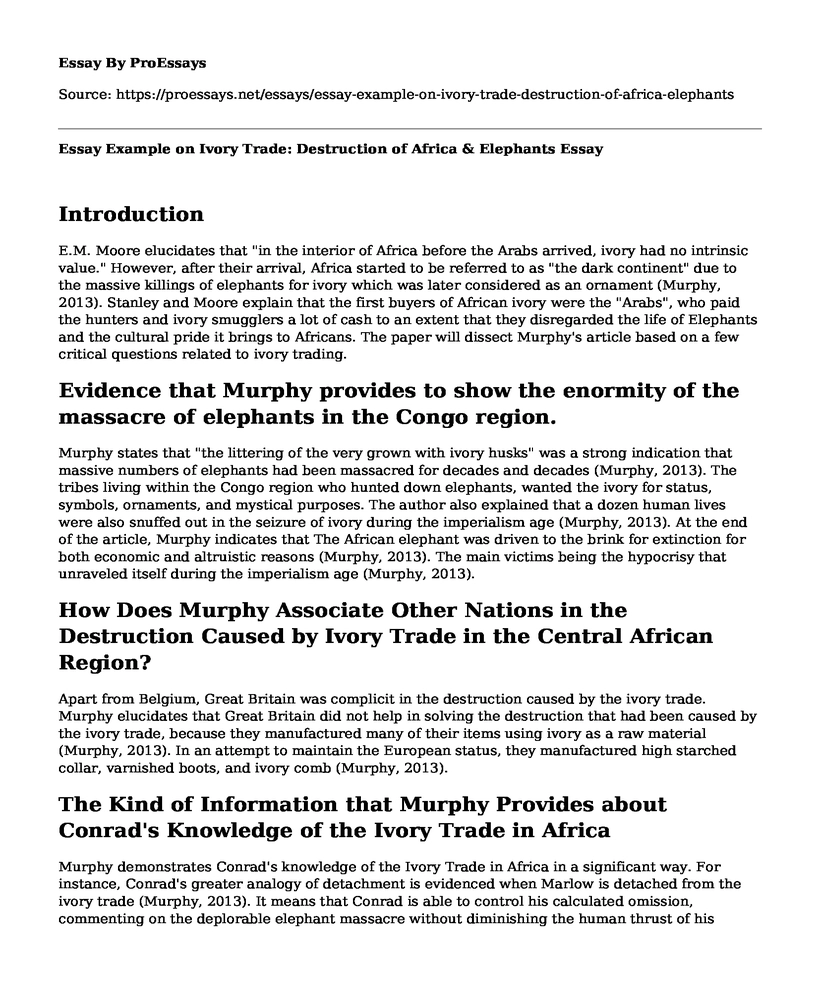Introduction
E.M. Moore elucidates that "in the interior of Africa before the Arabs arrived, ivory had no intrinsic value." However, after their arrival, Africa started to be referred to as "the dark continent" due to the massive killings of elephants for ivory which was later considered as an ornament (Murphy, 2013). Stanley and Moore explain that the first buyers of African ivory were the "Arabs", who paid the hunters and ivory smugglers a lot of cash to an extent that they disregarded the life of Elephants and the cultural pride it brings to Africans. The paper will dissect Murphy's article based on a few critical questions related to ivory trading.
Evidence that Murphy provides to show the enormity of the massacre of elephants in the Congo region.
Murphy states that "the littering of the very grown with ivory husks" was a strong indication that massive numbers of elephants had been massacred for decades and decades (Murphy, 2013). The tribes living within the Congo region who hunted down elephants, wanted the ivory for status, symbols, ornaments, and mystical purposes. The author also explained that a dozen human lives were also snuffed out in the seizure of ivory during the imperialism age (Murphy, 2013). At the end of the article, Murphy indicates that The African elephant was driven to the brink for extinction for both economic and altruistic reasons (Murphy, 2013). The main victims being the hypocrisy that unraveled itself during the imperialism age (Murphy, 2013).
How Does Murphy Associate Other Nations in the Destruction Caused by Ivory Trade in the Central African Region?
Apart from Belgium, Great Britain was complicit in the destruction caused by the ivory trade. Murphy elucidates that Great Britain did not help in solving the destruction that had been caused by the ivory trade, because they manufactured many of their items using ivory as a raw material (Murphy, 2013). In an attempt to maintain the European status, they manufactured high starched collar, varnished boots, and ivory comb (Murphy, 2013).
The Kind of Information that Murphy Provides about Conrad's Knowledge of the Ivory Trade in Africa
Murphy demonstrates Conrad's knowledge of the Ivory Trade in Africa in a significant way. For instance, Conrad's greater analogy of detachment is evidenced when Marlow is detached from the ivory trade (Murphy, 2013). It means that Conrad is able to control his calculated omission, commenting on the deplorable elephant massacre without diminishing the human thrust of his narrative critique. He states that European nations, such as Britain wanted the ivory to gain economic value and also maintain the European civilization (Murphy, 2013). Finally, Murphy depicts Conrad's "Heart of Darkness" as a story that helped enlighten the Western world of the adverse effects of imperialism in Africa (Murphy, 2013).
Conclusion
In conclusion, Exterminating the Elephant in Heart of Darkness by Murphy depicts ivory trade as a negative business that leads to the rise of the slave trade and massive massacre of Elephants for their tusks. From a broad perspective, the reader is able to view ivory trade as a negative activity of imperialism in Africa by the major European powers, such as Britain, France, Germany, and Belgium who used for altruistic and monetary gains (Murphy, 2013).
References
Murphy, R. F. (2013). Exterminating the Elephant in" Heart of Darkness". The Conradian, 38(2), 1-17.
Cite this page
Essay Example on Ivory Trade: Destruction of Africa & Elephants. (2023, Mar 28). Retrieved from https://proessays.net/essays/essay-example-on-ivory-trade-destruction-of-africa-elephants
If you are the original author of this essay and no longer wish to have it published on the ProEssays website, please click below to request its removal:
- The House of Pine Retail Store Business Plan
- Essay Example on Multinational Companies Reap Benefits in China Market
- Essay Sample on Best Buy: An American Online Retail Giant Selling Thousands of Products
- Army Forces Ops: Mission Command & Control - Essay Sample
- Paper Sample on Marjorie Spruill's Divided We Stand: A Battle Over Women's Rights & Polarized Politics
- Essay Sample on Tackling Gun-Related Issues in America: The Influence of Lobbying
- Free Essay Sample on Fossil Fuels: The Non-Renewable Energy Source







